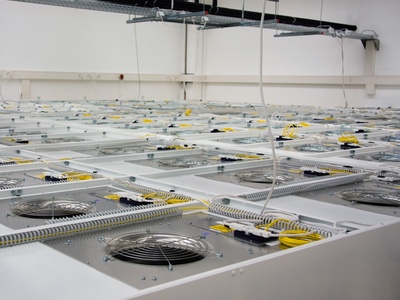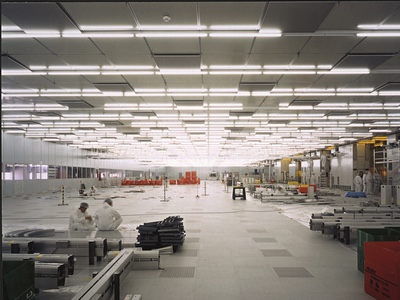Delivering optimum manufacturing environments requires the design and build of cleanroom facilities that meet stringent standards in the production process of pharmaceuticals. However, scalable manufacturing methods, compartmentalised production and sterile and non-sterile classifications provide manufacturers with a number of options and subsequent efficiencies of operation.
As the industry looks to drive efficiencies through the value chain — including the supply and manufacturing process — the race is on to find an energy efficient procedure for controlled environments that maintains the right quality and temperature at the lowest possible price. Michael Rodd, Chief Sales Officer at M+W Products, puts the role of the cleanroom in the pharmaceutical sector into context and signposts how future practice is changing the traditional concept of cleanroom procedures as the cleanroom technology industry pushes the frontiers of controlled environments and scalable solutions, whilst demanding cost-effective and greener results.
Common perceptions of cleanroom policy date back to the introduction of the notion that sterile and hygienic environments — and importantly equipment — make for successful outcomes. Such a “radical” thought process was introduced by British surgeon Joseph Lister in 1867, at a time when multiple surgical procedures were performed using the same contaminated equipment. Using carbolic acid and implementing this technique on wounds and needles to discover that the elimination of bacteria was a key catalyst in the development of contamination control remains the basis for effective clean environments.
Fast forward to the present day and the pharmaceutical industry has witnessed a progressive development in how manufacturing environments can and should be created, albeit based on the same principles regarding the need to provide sterile environments of varying degrees. Contamination control still remains at the heart of any successful cleanroom operation. This necessarily impacts on the processes employed in cleanroom technologies during the production of medicines, pharmaceuticals and biological compounds.
Control of the environment around pharmaceutical manufacturing informs the design and operation of facilities to ensure product quality and safety. Contamination control is where we start in terms of developing appropriate cleanroom solutions, including compartmentalised rooms and process areas. Facility design and control considerations include environmental controls (temperature, humidity and pressure), air quality (particulate and microbiological), facility finishes, gowning and flow procedures, equipment containment, system integrity and cleaning procedures. Regulatory requirements have historically influenced the development of these control areas, which differ between types of facility; for example, synthetic chemical bases will demand certain process and production areas whereas live organisms utilised in biopharmaceutical manufacturing will dictate the need for different sterile and non-sterile areas. Contamination control is therefore fundamental to the development of life science and pharmaceutical manufacturing.
Implementing change
Today, the process of industrial-scale pharmaceutical drug manufacturing is broken down into a wide variety of constituent parts, including, milling, granulation, coating, tablet compression and hot metal extrusion, resulting in multiple areas for contamination control to become a potential issue. In the past, the pharmaceutical industry — being regulated and protected from strong competition — had accepted the necessity of basing production on processes that would remain unchanged throughout their entire lifecycle, regardless of their weaknesses; reproducibility was identified as the essential element to preserving product quality and safety.
Now, with increasing competition and price pressure, there is a need to introduce efficiency tools to enhance new approaches throughout the entire product lifecycle. For instance, it should be possible to challenge cleanroom classification or area segregation on the production floor. It is expected that good production principles, focused on adding value, may alter production organisation to minimise waste within a manufacturing process, such as moving non-value steps — cleaning-in-place (CIP) and sterilisation-in-place (SIP), for example — out of the main production flow.
The implementation of closed systems represents one of the biggest visual changes to the production floor. If products are not exposed to the immediate room environment, there should be no concerns regarding contamination or cross-contamination within the atmosphere. With a robust risk assessment in place to validate this, it should be possible to move production outside of the cleanroom — such as in controlled non-classified (CNC) spaces – and unify products in one single production hall.

Accordingly, CNC areas can be regarded as clean — within definitive purposes of the word — in respect to the production area, but they are not actually classified because they work on a process defined as good manufacturing practice (GMP) or current good manufacturing practice (cGMP). The measurement most universally applied is the Grade A–D standard, whereby a cubic foot sample is taken of the environment and the number of particles greater than 0.5 mm are measured within it. Areas are classified on a graded system from A onwards, with A being the cleanest. The purpose of a low-quality CNC is to effectively get as close as possible to classification. Grade D-certified environments accept the inclusion of certain particles even in dynamic conditions (when people are operating within contained vessels) with turbulent airflow, whereas A-certified environments deal with linear laminated airflow that is non-turbulent. Cleanliness is commonly achieved through the development of effective HEPA (High Efficiency Particulate Air) filtration and this is considered as clean as necessary for a GMP Grade A condition.
This grade system is applicable in cases when products are exposed during the transportation of chemicals, or operations that are required to be performed outside of sealed compartments. Grade B commonly refers to high purity but does not necessarily involve laminate airflow, as long as airflow is maintained at a certain speed. Essentially, imagine the onion concept: each time a layer of the onion is peeled, the amount of particulate or contaminated risk to the product is reduced.
First principles
Here, let’s take the opportunity to remind ourselves of first principles: from the outset, the apparatus used for pharmaceutical drug manufacturing in cleanroom laboratories should be dedicated and separated from other areas. This is because humans remain the biggest cause of contamination; that may never change. To put this into perspective, the outer layer of human skin can host up to 1 million micro-organisms per square centimetre, and equally, human saliva up to 1 billion per square millilitre. Essentially, this involves the classification between protecting the working environment and protecting the operator from any potential contamination.
Such a multiplicity of potential contaminants presents a continual challenge at every stage of the process. Basic negligence can cause the micro-organisms from our clothes, ancillary equipment or bare skin to contaminate working stations. For instance, hands, whether gloved or ungloved, are one of the main sources of spreading infection or transferring microbial contamination. Thus, an important part of good contamination control within a cleanroom requires the use of cleaning disinfection agents.
It goes without saying that just as humans may be the biggest contaminants, they are also critical to the maintenance of asepsis within a controlled environment. Therefore, diligence and training in cleanroom methodology is essential throughout the process. The improper analysis of microbiological inspections may cause inadvertent contamination. Therefore, thorough aseptic processing (product or microbial bioburden, for example) to calculate viable organisms is needed to prevent any sort of contamination during the process stream. In some cases, even measuring total particulate count within a vessel does not cater for the continuous generation of organisms by individuals; therefore, it does not always account for all contaminants, which means the whole picture of microbiological content cannot be observed.

Micro-organisms will associate with physical particulates, so it is necessary to include monitoring techniques that satisfy both the classification and regulatory requirements by differentiating the microbiological components of an operation. The stringent optimisation of tests will give assurance that the bioburden of the environment is suitable for clean laboratory practices.
In the context of drug manufacturing, controlled environments, and therefore, clean laboratory practices, are necessary for the production of drugs such as those in liquid form. This is because of the need for contained process equipment and purified raw materials to prevent microbiological and particulate contamination. In addition, it is necessary to reduce personnel exposure to pharmaceutical products wherein mixtures containing high proportions of active drug substances are in use.
For any executive with bottom line responsibilities, however, this all costs money, and cleanrooms are an expensive piece of technology packed real estate. Therefore, with a view to future-proofing, considerations regarding the improvement in efficiencies that challenge traditional multiple air changes, in conjunction with the constant R&D of technology innovations, will push the industry into new territories. Although this is a big ask, it is essential to ensure that products and systems keep pace with the demand for efficiencies in such a competitive, dynamic and resource-driven industry.
